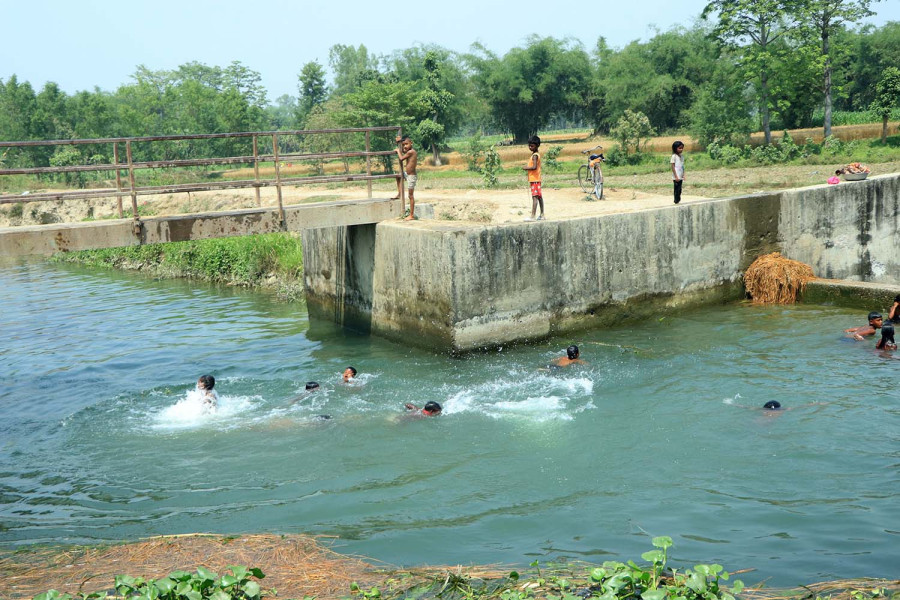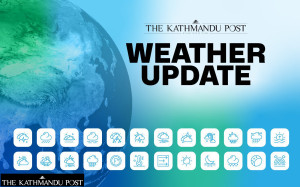Weather
Temperatures of many districts in Tarai region exceed 40 degrees Celsius
Heat wave conditions to continue for next three days, and western disturbances likely to cause rainfall next week, Met division says.
Post Report
People residing across the Tarai region will not have a sigh of relief from the sweltering heat for at least three days as there is no system in place to bring clouds or cause rainfall, the Meteorological Forecasting Division predicts.
The temperatures of many districts across the Tarai region have exceeded 40 degrees Celsius.
“Day temperatures will continue to increase in most parts of the country in the next three days, as no system is currently in place to cause rainfall,” said Raju Pradhananga, senior divisional meteorologist at the division. “Heatwave conditions, which have been continuing for the last two weeks, will be prolonged further.”
Locals in the Tarai region complain that life has become too difficult due to excessive heat.
“It is very difficult to come out of home after 10 in the morning due to hot air, dust and high temperature,” said Kiran Poudel, a local from Bhairahawa of Rupandehi district.
Health facilities of the region have been grappling with an uptick in cases of diarrhoea, vomiting, and urinary infections, among other ailments.
The Met division under the Department of Hydrology and Meteorology said that on Wednesday, the maximum temperature of the 20 Met stations, mostly of Tarai districts, remained between 40 and 45, 17 districts had 35 to 40 degrees Celsius, and 19 districts had 30 to 35 degrees Celsius.
Experts say a heat wave occurs when the maximum and minimum temperatures at a location are unusually high over three consecutive days.
One could feel tiredness, weakness, thirst, headache, leg cramps, muscle pain, vomiting, dizziness and fainting due to exposure to excessive heat, according to the department.
Heat-related illnesses include heat stroke, heat exhaustion, heat cramps and heat syncope (fainting). Heat stroke is the most severe form of heat-related illness and requires immediate medical attention.
Officials said if the maximum temperature at a place exceeds 40 degrees Celsius, residents should immediately take precautions. They advised people not to venture out of home in the afternoon, take sufficient fluids and water to remain hydrated, and wear cotton clothes so as to avoid adverse effects of the scorching heat.
Locals, however, complained that these suggestions are good only for those who can afford to stay at home.
According to the Met division, the maximum temperature of Bhairahawa reached 43 degree Celsius, Janakpur 42.4, Biratnagar 40.2, Simara 41.5, Nepalgunj 37.6 and Dhangadhi 39.4 degrees Celsius on Thursday. Kathmandu recorded 33.5 degrees Celsius, the maximum temperature this year. Kathmandu recorded 36.6 degrees Celsius on May 7, 1989, the most extreme temperature ever recorded.
The World Health Organisation said that heatwaves are among the most dangerous of natural hazards, but they rarely receive adequate attention because their toll and destruction are not always immediately obvious.
People’s exposure to heat is increasing due to climate change. Globally, extreme temperature events are observed to be increasing in their frequency, duration and magnitude, according to the UN health body.
Nepal is one of the most vulnerable countries in the world to the climate crisis and has witnessed extreme weather events increasingly over the past decade and a half.
The average annual maximum temperature of Nepal has risen by 0.056 degrees Celsius, according to a study conducted by the Department of Hydrology and Meteorology in 2017. The study shows most districts witnessed increasing temperatures annually.




 11.12°C Kathmandu
11.12°C Kathmandu



%20(1).jpg&w=300&height=200)

